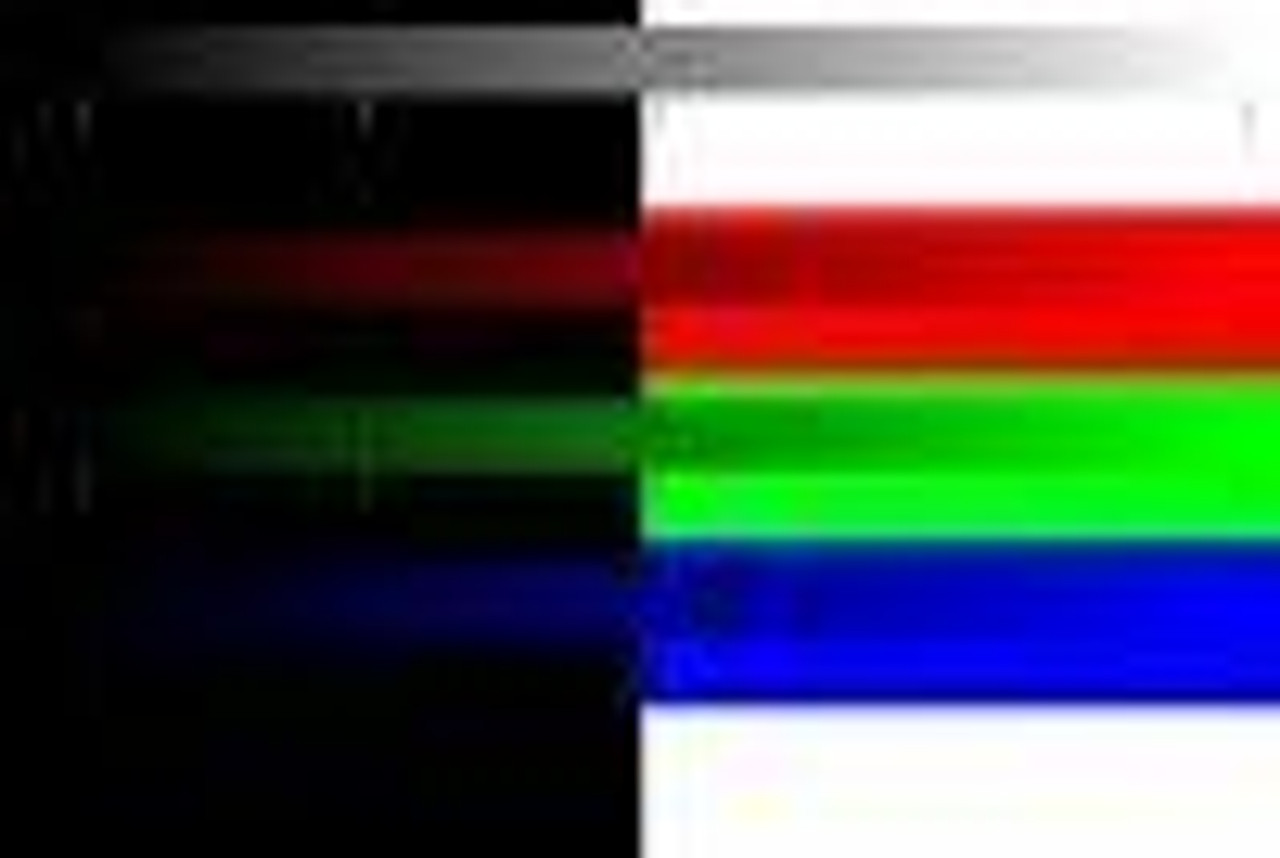Adjusting your Display with the HDNet Test Pattern
 Sometimes on Tuesday morning at 6:00AM eastern time, HDNet broadcasts a series of test patterns. Below is a basic guide for how to use them to make some basic display adjustments to improve your HDTV picture. Here is their description of the program...
Sometimes on Tuesday morning at 6:00AM eastern time, HDNet broadcasts a series of test patterns. Below is a basic guide for how to use them to make some basic display adjustments to improve your HDTV picture. Here is their description of the program...
HDNet Test Patterns: Wonder how your home theatre is doing? Wish you had test patterns to help set it up? Well, HDNet is here to help. This short program will help you get the most out of your home theatre setup by providing you with the same professional test patterns HDNet uses to set their gear.
Pattern 1: Color Bars - Setting COLOR and TINT: If you have a blue filter (such as from the Avia or Digital Video Essentials DVD's you can use this pattern to set COLOR and TINT. But, this pattern is not actually very good for that purpose. While looking through the blue filter you need to match the levels of the blue and white bars while adjusting COLOR, and match the levels of the cyan and magenta bars while adjusting TINT. Since neither pair is right next to each other this is very difficult do do with this pattern.
Setting CONTRAST (or PICTURE) and BRIGHTNESS: Using the gray patches with numbers across the bottom you can make some reasonable CONTRAST and BRIGHTNESS adjustments. To adjust brightness, look at the rightmost square which actually has a very dim number 10 in it. You should just barely be able to make out the number 10. If you can see it clearly your BRIGHTNESS is too high. If you can't see it at all your BRIGHTNESS is too low. I would recommend turning down BRIGHTNESS until you can't see it and then gradually raising it until you just make it out. That does not mean your brightness will be perfect as there are other issues that can affect it. One is ambient light. You will probably notice that you would set it differently if the room is totally dark vs. if there is ambient light. Also, some displays don't "hold black" very well which means the brightness varies depending on the overall luminance of the image. This test pattern is pretty average, but if you watch lots of dark programming (movies) or lots of bright programming (sports) you may still need to adjust brightness one way or another.
If you have a fixed pixel display (DLP, LCD, etc.) you can make sure you aren't crushing the whites or maxing out one of the colors by having your CONTRAST too high. Look at the leftmost (white) square and make sure you can see the number 0 in it. If not, lower CONTRAST until you can. You may then still notice a significant color shift between the 0 square and the 1 square. On DLP's you'll usually notice the 1 square looks reddish. If you see this, continue lower contrast until the two squares look about the same color of gray.
Adjusting CONTRAST will affect BRIGHTNESS and vice versa so go back and forth until they both look good.
Pattern 2: Crosshatch: Use this pattern to adjust CONVERGENCE (CRT based displays only). Look at the grid and make sure all the lines are white. You shouldn't have blue or red fringes and the lines shouldn't separate into 3 colors on parts of the screen. Use your CONVERGENCE controls to do the best you can to make all the lines white.
You can also use this pattern to adjust focus on front projectors, focus until the crosses are as crisp as possible. On fixed pixel displays get right up to the screen and see how clear the individual pixels look to really dial it in.
Pattern 3: Overscan, Resolution and Sharpness: Use this pattern to set your SHARPNESS. Look at the black grid lines and outer edge of the circle and the black text on gray background in the square on the left and look for white "outlines" on either side. You should attempt to lower SHARPNESS to reduce the white highlights as much as possible. But, when you do so, pay attention to the resolution patterns. If the wedges start turning into gray mush as you lower sharpness, you'll have to make a compromise. Lowering SHARPNESS too much will reduce your resolution, but raising it too much will increase the undesirable edge enhancement.
To set overscan, you need to check that the numbers on the sides are roughly 2X the numbers on the top and bottom. I've anaylized it in detail here. The pattern does not represent actual overscan percentages but there is a formula that will let you compute them from the numbers displayed on this pattern.
If you really want to get it as good as possible, I'd recommend an ISF calibration as a calbrator should use a test pattern generator with better patterns for adjusting these things and will also be able to calibrate your grayscale for more accurate colors but with the information above you should be able to get a good start.


